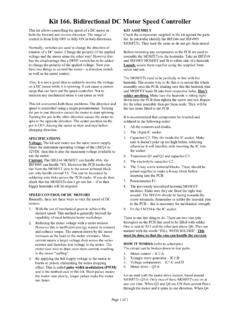Transcription of KIT 61. GENERAL PURPOSE 3 1/2 DIGIT LED PANEL METER
1 kit 61 . GENERAL PURPOSE 3 1/ 2 digit led panel meter . In Kit 34 we presented a GENERAL PURPOSE 3 1/2 DIGIT PANEL Display PCB. Fit the 4 LED displays to the display PCB. METER (DPM) using the 7106 IC and an LCD. The sister by following the overlay and solder. Do not attach to the chip to the 7106 is the 7107 which uses an LED display mother board yet. That will be the last thing to do. for its output. There are two advantages to using the 7107. over the 7106. The first is that because it is powered by Main PCB. It is easiest to solder the lowest height +5V and -5V it can accept inputs in the range +4V to - components first - the diodes, resistors monoblock 4V. A second advantage is when a digital reading of zero capacitors and the single link. Use some of the leads cut is desired for a VIN not equal to zero as, for example, off from the resistors to attach four wires coming out of temperature and weighing systems with a variable tare.
2 The TEST, REF HI & REF LO pads. These will be used Both the offset voltage and the transducer voltage later. Note that R5 R6 R7 stand up on the board. The can be conveniently input directly to the 7107. In 7106 link and 3 of the components fit under the 7107 IC. Then systems null calibration requires additional electronics attach the IC sockets, switches and remaining off-chip. components. Watch the orientation of the electrolytic capacitors and the two IC's. The two terminal blocks kit 61 has been designed as a versatile 3 1/2 DIGIT PANEL which are next to each other slide together in a tongue &. METER with these considerations in mind. Also in this Kit groove arrangement. Put them together before soldering we have used small, monoblock capacitors rather than the them. We have supplied resistor RY1 of 10M resistance.
3 Much bigger mylar or metallized types. This saves space Because the input impedance of the 7107 is so high this as well as making the METER look better. Some will make sure that the display does not pick up stray components are under the IC to save even more space. charge and will calibrate correctly when you first turn it on. Leave this resistor in place except when you use the Voltage is the most frequently measured electrical input voltage divider as explained below. quantity. In DPM's to measure temperature, current, wind speed, resistance, lux etc., what is actually being The last step in construction is to attach the two PCB's measured is voltage. After calibrating the METER for its together using the 27 pin post header connector. The particular PURPOSE the voltage measured will give an short, 90o pins fit into the top of the mother board.
4 Solder accurate digital reading of the analog quantity being it into place first. Then fit on the display board to the long measured. straight pins. Make sure you get the display board the correct way around. Look for the V+and the G pins. Digital displays have many advantages over analog These are marked on both PCB's. On the display board it meters which use a pointer and moving coil. Firstly they is marked on the bottom side under the solder mask.). are easier to read especially by unskilled labour. In the Make sure you match them up: V+ to V+, G to G. majority of applications it is better that the value displayed is exactly the value being measured, for Connect +5V to the board and turn it on. Put the switch example, To use an analog display with its many in the Normal position.
5 When the TEST pin 37 of the graduated scales (some going up and others going down) 7107 is connected to VCC then the display should read - and switches requires considerable practice. But a simple 1888. You can easily do this by touching together the two LED display which reads ' ' can be understood by wires you previously soldered into the two pads at TEST. everyone. This will tell you that the IC and the display are working correctly. Second, DPM built using the 7107 are physically stronger and more robust than analog meters because they have no WHAT TO DO IF IT DOES NOT WORK. moving parts. Thirdly, for the manufacturer the assembly Poor soldering is the most likely reason. Check all solder of the complete DPM unit can be done by relatively joints carefully under a good light.
6 Next check that all unskilled labour in third world countries. Fourthly, the components are in their correct position on the PCB. 7107 by its very nature can be adapted to so many uses at Thirdly, follow the track with a voltmeter to check the such a low cost that it has actually created markets for potential differences at various parts of the circuit. Check itself. All of these factors add up to a better, cheaper that -5V is going to pin 26 of the 7107. product which everyone can afford. CIRCUIT DESCRIPTION. Two circuit boards have been used. The 4 LED displays As you can see from the schematic on the previous page mount on one board which is soldered to the mother most of the connections are between the 7107 and the board at right angles. This allows low profile end LED's.
7 The 7107 contains a number of inputs which can viewing. be varied to do different things. Of prime importance is the reference voltage, VREF, which is set by the 10K. The kit is constructed on single-sided printed circuit trimpot and R3. These will be discussed below. boards. Protel Autotrax & Schematic were used. -5V Generation. With the addition of only two ASSEMBLY INSTRUCTIONS capacitors the 7660 IC performs the complete supply Check the components in the Kit against the Component voltage conversion from positive to negative for an input listing. Make sure you identify every component. range of to 10V, resulting in complementary output voltages of to -10V. kit 61 . GENERAL PURPOSE 3 1/ 2 digit led panel meter . VIN = 2 x VREF. 7107. The heart of the METER is the a/d converter built into the 7107.
8 It uses a dual slope conversion technique. It And VREF must be in the range 100mV to relies on the charging and discharging of an integrating capacitor and having a counter count when the capacitor Components supplied in this Kit are for VREF of 100mV. voltage is above a set value. Since the capacitor discharge For a VREF of 1V two components should be changed (as is linear the counter reading is proportional to the input mentioned above) to maintain sensitivity and recovery voltage. There are three phases to the process: from over-voltage. The 10K trim pot and resistor R3 will allow adjustment for either value, and for intermediate Phase 1. Auto Zero. The autozero capacitor is charged to values when required (discussed below.) In the following the integrators offset voltage.
9 This voltage is subtracted discussion we will assume that we are using a VREF of from the input signal during phase 2. The integrator thus 100mV. appears to have zero offset voltage. Calibration is done by attaching a (preferably digital). Phase 2. Signal Integrate. The signal input is averaged multimeter to REF HI and REF LO and adjusting the for trimpot to read 100 mV. This is why wires were put into 1000 clock pulses. these pads during construction. Now the METER is calibrated to read 0 - Phase 3. Reference Integrate. Input low is internally connected to Common (which may be an offset voltage.) Voltage Divider. To measure voltage greater than VREF is averaged back to either zero volts or the offset an input voltage divider is required. See the figure below. voltage over another 1000 clock pulses.
10 The number of This is the PURPOSE of the space for 4 resistors on the clock pulses counted to return to this value is a digital main circuit board. The GENERAL relation for full scale measure of VIN. sensitivity is now: System Timing. This is determined by the components VIN (full scale) = 2 VREF x RY / ( RX + RY). connected to pins 38, 39 & 40. Values are unchanged for all ranges measured. The internal oscillator runs at For example, a 0 - 20V range (when VREF is ) can be 48kHz, or 3 readings per second. obtained using a 100:1 voltage divider. This can be done by making RX = 1M and RY = 10K. The decimal point Decimal Point. A jumper selects the decimal point jumper is placed at position '2' so a full scale display of position in the displays. is indicated. Similarly, a 0 - 200V range can be obtained with RX = 1M and RY = 1K.








